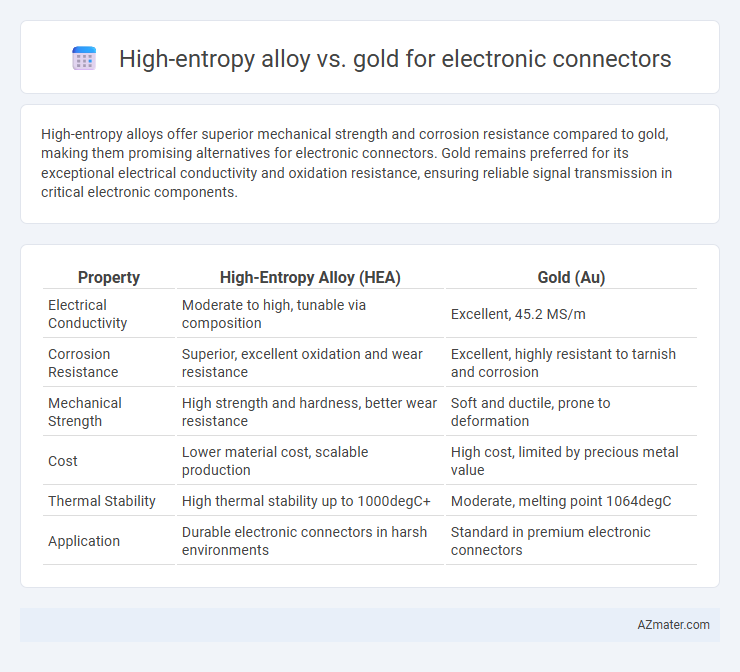High-entropy alloys offer superior mechanical strength and corrosion resistance compared to gold, making them promising alternatives for electronic connectors. Gold remains preferred for its exceptional electrical conductivity and oxidation resistance, ensuring reliable signal transmission in critical electronic components.
Table of Comparison
| Property | High-Entropy Alloy (HEA) | Gold (Au) |
|---|---|---|
| Electrical Conductivity | Moderate to high, tunable via composition | Excellent, 45.2 MS/m |
| Corrosion Resistance | Superior, excellent oxidation and wear resistance | Excellent, highly resistant to tarnish and corrosion |
| Mechanical Strength | High strength and hardness, better wear resistance | Soft and ductile, prone to deformation |
| Cost | Lower material cost, scalable production | High cost, limited by precious metal value |
| Thermal Stability | High thermal stability up to 1000degC+ | Moderate, melting point 1064degC |
| Application | Durable electronic connectors in harsh environments | Standard in premium electronic connectors |
Introduction to Electronic Connectors
Electronic connectors serve as crucial interfaces enabling electrical signals and power to flow between devices, requiring materials with excellent conductivity, corrosion resistance, and mechanical durability. High-entropy alloys (HEAs) offer promising properties such as superior strength, wear resistance, and thermal stability, potentially enhancing connector lifespan and performance under harsh conditions compared to traditional gold contacts. Gold remains widely used for its exceptional electrical conductivity and resistance to oxidation but presents cost and mechanical softness challenges that HEAs aim to address in advanced electronic connector applications.
What Are High-Entropy Alloys (HEAs)?
High-entropy alloys (HEAs) are advanced materials composed of five or more principal elements mixed in near-equal atomic percentages, offering exceptional mechanical strength, corrosion resistance, and thermal stability. Compared to gold, a traditional material used in electronic connectors for its excellent electrical conductivity and corrosion resistance, HEAs provide enhanced wear resistance and mechanical durability in harsh environments. These properties make HEAs promising candidates for next-generation electronic connectors requiring high performance under demanding operational conditions.
Gold in Electronic Connector Applications
Gold offers exceptional corrosion resistance and excellent electrical conductivity, making it a preferred choice for electronic connectors where reliable signal transmission is critical. Its inherent softness allows for good contact compliance, ensuring low contact resistance and minimal signal loss over time. Despite higher material costs, gold plating enhances connector durability and maintains performance in harsh environments, essential for high-reliability electronics.
Electrical Conductivity: HEA vs Gold
High-entropy alloys (HEAs) offer competitive electrical conductivity compared to traditional gold connectors, typically ranging between 1 to 10 MS/m, whereas gold's conductivity is approximately 45 MS/m. Despite lower conductivity, HEAs provide superior mechanical strength, corrosion resistance, and thermal stability, making them viable alternatives in extreme environments. Innovations in HEA composition optimization are narrowing the conductivity gap, enhancing their potential for high-performance electronic connector applications.
Corrosion Resistance Comparison
High-entropy alloys (HEAs) exhibit superior corrosion resistance in electronic connectors due to their complex multi-element composition, which creates a stable passive oxide layer that prevents degradation in harsh environments. Gold, while highly corrosion-resistant and an excellent conductor, can suffer from softening and wear under mechanical stress, limiting its durability in long-term connector applications. The enhanced corrosion resistance of HEAs offers longer service life and reliability in electronic connectors exposed to aggressive conditions compared to traditional gold coatings.
Mechanical Strength and Durability
High-entropy alloys (HEAs) outperform gold in mechanical strength and durability for electronic connectors due to their multi-element composition, which enhances resistance to wear, deformation, and fatigue. HEAs exhibit superior hardness and tensile strength compared to gold's relatively soft and malleable nature, making them ideal for connectors subjected to mechanical stress and frequent mating cycles. The enhanced mechanical properties of HEAs translate to longer service life and improved reliability in harsh operating environments where gold connectors may suffer from creep and mechanical degradation.
Cost Efficiency: HEA vs Gold
High-entropy alloys (HEAs) offer significant cost efficiency over gold for electronic connectors due to their lower raw material expenses and enhanced durability, reducing long-term replacement and maintenance costs. While gold provides excellent electrical conductivity and corrosion resistance, its high market price and susceptibility to wear increase overall costs in high-volume manufacturing. HEAs deliver a balanced combination of mechanical strength and corrosion resistance, making them a cost-effective alternative for reliable electronic connectors in demanding applications.
Manufacturability and Scalability
High-entropy alloys (HEAs) offer superior manufacturability for electronic connectors due to their enhanced mechanical properties and resistance to wear, enabling precise machining and stable performance under harsh conditions compared to traditional gold plating. Scalability is advantageous for HEAs as their multi-element composition allows cost-effective bulk production with reduced reliance on scarce gold resources, addressing supply chain constraints and price volatility. Gold connectors excel in conductivity and corrosion resistance but face limitations in large-scale manufacturing due to material cost and depletion risks.
Environmental Impact and Sustainability
High-entropy alloys (HEAs) offer significant environmental advantages over gold in electronic connectors due to their reduced reliance on scarce precious metals and enhanced recyclability. HEAs can be engineered for high corrosion resistance and durability, extending connector lifespan and minimizing electronic waste compared to gold, which requires energy-intensive mining processes and generates substantial environmental degradation. Sustainable electronics benefit from HEAs' potential to lower carbon footprints and reduce toxic byproducts during production and disposal phases.
Future Trends in Connector Materials
High-entropy alloys (HEAs) exhibit superior mechanical strength, corrosion resistance, and thermal stability compared to traditional gold connectors, making them promising candidates for next-generation electronic connectors. Future trends emphasize the integration of HEAs to enhance reliability and performance in extreme environments, addressing limitations of gold's cost and susceptibility to wear. Advances in nanostructuring and alloy composition optimization are accelerating the adoption of HEAs in electronic interconnects, supporting more durable and cost-effective solutions.

Infographic: High-entropy alloy vs Gold for Electronic connector
 azmater.com
azmater.com